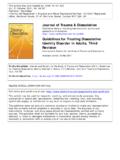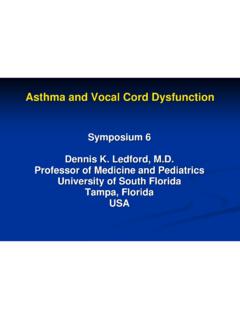Transcription of assessment and management of cannabis use …
1 800 BMJ | 10 april 2010 | VoluMe 340 CliniCal ReviewFor the full versions of these articles see and management of cannabis use disorders in primary careAdam R Winstock,1 Chris Ford,2 3 John Witton11 National Addiction Centre, Institute of Psychiatry, King s College London, London SE5 8AF 2 Substance Misuse management in General Practice (SMMGP), c/o NTA, Skipton House, London SE1 6LH324 Lonsdale Road, London NW6 6 SYCorrespondence to: a r Winstock this as: BMJ 2010;340:c1571doi: a third of adults in the UK have tried cannabis , and million people, mostly 16-29 year olds, have used it in the past Although most people who smoke cannabis will develop neither severe mental health problems nor depend-ence, regular use of cannabis may be associated with a range of health, emotional, behavioural, social, and legal prob-lems, particularly in young, pregnant, and severely mentally ill 3 The past decade has seen a shift in available cannabis preparations from resinous hash to intensively grown high potency herbal preparations, often referred to as skunk, which now dominates the UK Compared with traditional cannabis preparations, skunk tends to have higher levels of tetrahydrocannabinol, the main psychoac-tive constituent of cannabis , and lower levels of the anxi-olytic cannabinoid cannabidiol.
2 In January 2009 cannabis was returned to its original class B classification (from class C) under the UK Misuse of Drugs high levels of use, only 6% of those seeking treat-ment for substance misuse in England cite cannabis as their major drug of concern, and most of those with cannabis use disorders do not have cannabis use as their presenting com-plaint (box 1).5 Low levels of treatment seeking may reflect a lack of awareness of the associated harms of This review highlights the adverse health outcomes associated with cannabis and outlines optimal approaches to assessing and managing cannabis use in primary searched electronic databases, including Medline and PsycINFO; the Cochrane Library; specialist websites; data-bases of England s National Treatment Agency for Substance Misuse and of the UK centre DrugScope; the US National Institute on Drug Abuse; the European Monitoring Centre for Drugs and Drug Addiction; and Australia s National cannabis Prevention and Information Centre.
3 We also con-sulted primary care providers and specialists in addiction treatment. How does cannabis exert its effect?Metabolites of cannabis act on the body s endogenous cannabinoid system via type 1 cannabinoid receptors (CB1 receptors) in the central nervous system and CB2 receptors peripherally. They may modulate mood, memory, cognition, sleep, and are the effects of intoxication?Most people smoke cannabis for its relaxant and euphoriant effects (box 2). The impact of higher potency cannabis will depend partly on its ratio of tetrahydrocannabinol to can-nabidiol and whether users are able and willing to titrate their consumption as they might 6 The authors of a recent review suggested that more potent forms may increase the risk of dependence and adverse psychological pointSCannabis use is common, especially among young peopleThe greatest risk of harm from cannabis use is in young people and those who are pregnant or have serious mental illnessA tenth of cannabis users develop dependence, with three quarters of them experiencing withdrawal symptoms on cessationMost dependent users have concurrent dependence on tobacco, which increases the health risks and worsens outcomes for cannabis treatment Brief interventions and advice on harm reduction can improve outcomesPsychoeducation (for a better understanding of dependence), sleep hygiene, nicotine replacement therapy (where indicated)
4 , and brief symptomatic relief form the mainstay of withdrawal management Dependent users may present with symptoms suggestive of depression, but diagnosis and treatment should be deferred until two to four weeks after withdrawal to improve diagnostic accuracyBox 1 | What problems might cannabis users present with in primary care? Respiratory problems, such as exacerbation of asthma, chronic obstructive airways disease, wheeze or prolonged cough, or other chest symptomsMental health symptoms, such as anxiety, depression, paranoia, panic, depersonalisation, exacerbation of an underlying mental health conditionProblems with concentration while studying or with employment and relationshipsDifficulties stopping cannabis use Legal or employment problems (arising from use of cannabis ) Ж Listen to an interview with author Chris Ford, at | 10 april 2010 | VoluMe 340 801 CliniCal ReviewRoutes of use cannabis is often rolled in a cigarette paper and smoked with tobacco in a joint or spliff, and it produces inhaled carcinogens.
5 Most carcinogens in tobacco are present in cannabis . Typical cannabis use results in a larger volume of smoke being inhaled than with ordinary tobacco products and a fivefold increase in concentrations of Tetrahydrocannabinol is fat soluble and is absorbed from the gastrointestinal tract. Although oral ingestion of cannabis avoids the risks associated with smoking, sec-ondary active metabolites are formed and dose titration is Oral use may lead to intense, unpredictable pro-longed and risks associated with the use of cannabis Table 1 outlines the harms and risks associated with can-nabis use, such as acute and chronic effects and possible risks in specific with use at young ageLarge population based longitudinal studies have shown that the earlier the age of first use of cannabis , the greater the risk of dependence, other problems of substance misuse, mental health problems, and poor emotional, academic, and social w5 Vulnerability to the reinforcing positive effects of cannabis use and to dependence, has a heritable harmsCannabis smoking shows a dose-response relation with pul-monary risk in the same way that tobacco smoking does.
6 A longitudinal study of young cannabis smokers showed that regular heavy use can produce chronic inflammatory changes in the respiratory tract, resulting in increased symptoms of chronic bronchitis such as coughing, shortness of breath, pro-duction of sputum, and A study comparing results of pulmonary function tests and computed tomography scans across different smoking groups estimated that one cannabis joint caused the equivalent airflow obstruction associated with smoking two and a half to five A recent cross sectional study examining an older population of smokers suggests that concurrent smoking of cannabis and tobacco leads to synergistic respiratory harm, whereas smoking can-nabis alone probably does not lead to chronic obstructive pulmonary However, a large case-control study from New Zealand does suggest that cannabis smoking is an independent risk factor for lung malignancy; heavy smokers (more than 10 years of smoking cannabis joints) had a relative risk of after adjustment for age, tobacco use, and family history of lung A large prospective study found that cannabis use may be a risk for coronary events, especially in those with pre-existing cardiovascular health and cognitionObservational evidence associates cannabis use and psy-chotic disorders , but causality is not cannabis use is associated with double the risk of schizophrenia (from in 1000 to in 1000), and some evidence exists that starting use under the age of 16 years increases the A cross sectional study showed that a family history of psychotic illness and a personal history of unusual experiences raised the risk of psychotic illness associated with cannabis A recent review highlighted consistent evidence that onset Box 2 | Physiological and psychological effects of cannabis *Psychological (mood/perceptual)
7 EffectsA sense of euphoria and relaxation Perceptual distortions, time distortion, and the intensification of sensory experiencesImpairment of attention, concentration, short term memory, information processing, and reaction timeFeelings of greater emotional and physical sensitivity Anxiety, panic, and paranoia Physiological effectsIncrease in appetite Increase in heart rate, decrease in blood pressure Conjunctival injection and suffusion Dry mouth Impaired psychomotor coordination and sedation *The effects peak after 30 minutes and last for two to four hourstable 1 | Harms and risks associated with cannabis use. Adapted from the 2009 guidelines from Australia s National cannabis Prevention and Information Centrew7 and from Hall and Degenhardt3 Acute intoxication risksImpaired attention, memory, and psychomotor performance while intoxicatedIncreased risk of road traffic crashes, especially if cannabis is mixed with alcoholPsychotic symptoms at high dosesMost probable chronic effectsDependence (1 in 10 users)Subtle cognitive impairment in attention, verbal memory, and the organisation and integration of complex information in daily user (with >10 years use).
8 Some evidence of reversibility with prolonged abstinencePulmonary disease and respiratory symptoms such as chronic obstructive pulmonary disease and chronic cough (synergistic harm with tobacco)Malignancy of the oropharynxPossible chronic effectsXerostomia (dry mouth) and consequent dental health problemsSome evidence that cannabis may affect female fertilityIn utero exposure to cannabis may lead to low birthweight babies and later behavioural, problem solving, and attention difficultiesIncreased rate of lung cancerProbable risks in specific populationsImpaired personal and educational attainmentAdolescent cannabis use is associated with: higher rates of truancy, delinquency, and criminality; higher rates of problems of other substance misuse, including alcohol; poorer academic achievement and educational attainment, with more unemployment; lower levels of relationship satisfaction; possible exacerbation of mental health conditions such as depression, anxiety, and psychotic conditionsLimited or no evidenceBirth defects (except low birth weight, for which good evidence exists)802 BMJ | 10 april 2010 | VoluMe 340 CliniCal Reviewof schizophrenia presents earlier (by years)
9 In male cannabis A recent systematic review found that cannabis use was associated with increased relapse and non-adherence to medication in patients with sectional and cohort studies have found higher levels of depressive symptoms in cannabis users than in However, a systematic review concluded that cannabis use does not cause affective Rates of cannabis use are higher in those with anxiety disorders than in those without, and heavy users of cannabis have higher levels of anxiety, but the nature of this relation is not between chronic cannabis intoxication and psychiatric disordersThe presenting symptoms of chronic cannabis use and intoxication can sometimes be confused with those of depression (lethargy, sleep and appetite disturbance, social withdrawal, problems at work or at home, cognitive impair-ment). Symptoms may improve or resolve outside periods of intoxication or withdrawal. Psychiatric disorders that are unrelated to cannabis use may have been present before the onset of use and their symptoms are likely to persist with abstinence from cannabis .
10 If symptoms resolve when cannabis use ceases, the likelihood of a primary psychiat-ric diagnosis diminishes. In a small inpatient withdrawal study of 20 heavy users of cannabis , mean baseline depres-sion symptom scores reduced to normal levels after four weeks of The diagnosis of a depressive dis-order and start of antidepressants should therefore usually be deferred until after a period or two to four weeks of absti-nence. Resolution of affective symptoms after cessation may act as a good motivator for maintaining abstinence (see the full version of this article on for figure 1, a decision pathway for assessing affective symptoms in cannabis users).Recent imaging studies have identified reductions in the volumes of the amygdala and hippocampus that are related to cannabis use,18 consistent with studies that have identi-fied duration of use and dose related impairments in mem-ory and attention in long term heavy users of the cannabis user for whom use is a problemAlthough problems of cannabis use can arise at any level of use, however low, cannabis use disorders and other problems are more likely to arise in long term, heavy daily users than in casual, infrequent users.




